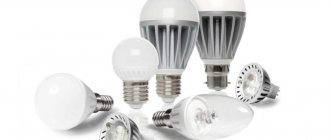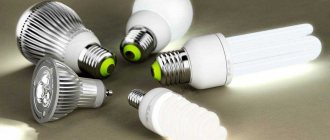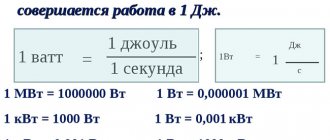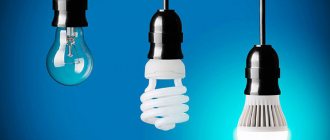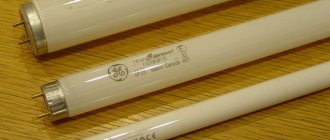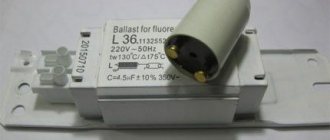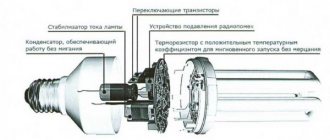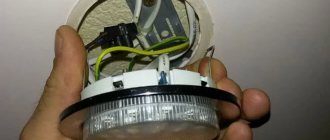- Features of fluorescent lamps
- Types of fluorescent lamps
- Advantages and disadvantages of fluorescent lamps
- LED lamps: the best replacement for fluorescent lamps
- What is the advantage of LED lamps?
- How to convert a fluorescent lamp to LED?
For decades, fluorescent lamps have been widely used to illuminate a variety of rooms in homes, offices and businesses. People have long come to terms with their shortcomings, perceiving frequent breakdowns, flickering and tedious humming as an inevitable evil. But with the advent of LED lamps on the market, the situation has changed dramatically. Economical, inexpensive and energy-efficient LED emitters have become the best replacement for obsolete lighting fixtures.
However, buyers still doubt the advantage of LED lamps over energy-saving fluorescent lamps, which were very popular a couple of years ago. We decided to objectively compare these two lighting options to help ordinary users understand such a pressing issue.
Main types of energy-saving lamps
There are certain categories of lighting fixtures that have a light output many times greater than that of traditional incandescent lamps. At the same time, the electricity consumption of both will be approximately the same.
Such light sources are considered energy-saving, with a higher efficiency. They consume approximately 5 times less electricity per unit of luminous flux, with minimal thermal and other losses. All energy-saving light bulbs are combined into two main groups.
Fluorescent lamps
They entered this category relatively recently, since the tube configuration did not allow obtaining the desired effect. For normal operation, it was necessary to use special lamp designs, and installation and replacement are still considered very inconvenient. With the advent of compact shaped lamps, the situation has completely changed. These devices now have bases that can be screwed into ordinary lamps.
The design of such lamps includes the following components: a glass bulb filled with argon and mercury vapor, a base and a ballast. The last element ensures the generation of electromagnetic radiation and the directed movement of electrons from the spiral. Next, a glow discharge occurs, causing ultraviolet radiation in mercury vapor. When this radiation hits the phosphor, it undergoes transformation and turns into visible light.
Light-emitting diode (LED) lamps
In these devices, light is created by special semiconductor devices - LEDs. When connected to power, they begin to emit light. These lamps consume minimal amounts of electricity while maintaining high light output and brightness. A 6-watt LED bulb produces the same amount of light as a 60-watt incandescent bulb. Electricity consumption is approximately 8 times lower.
Calculation of payback when replacing lamps with LEDs
Let's compare a 10 W LED bulb for 200 rubles and a 15 W LL for 150 rubles. Based on the minimum service life of the latter (50 thousand hours), you will have to buy 7 pieces of luminescent products, the total cost is 1050 rubles.
If the lighting device is lit for 5 hours a day, the LL spends 0.3 kW, LEDs - 0.2 kW. For a month you get 9 and 6 kW, in rubles at a tariff of 4 rubles per kilowatt - 36 and 24 rubles, for a year - 432 and 288 rubles. At first glance, the difference is small.
This is a calculation for one light bulb, and in any apartment there are several lamps that differ in power. If you carry out the calculation for each, the result will be more impressive.
When calculating, it is also necessary to take into account replacement costs. The highest costs are when completely replacing lamps. You can save money if you buy LED products of similar sizes with the same base.
If we take into account the most important parameter - light output, the advantage of LEDs is even more obvious, because an LED source with the same number of lumens as an LL illuminates the space better.
Comparison of main parameters and characteristics
There are several criteria used to compare different types of lamps.
The main indicators of performance and functionality are the following:
- The amount of luminous flux. It is used primarily for comparison and is tied to parameters such as energy efficiency and cost-effectiveness. Both of these indicators are taken from conventional incandescent lamps, and based on the data obtained, further comparisons are made. The amount of luminous flux shows the degree of illumination of a particular room. The unit of measurement is lumen (Lm). The higher this indicator, the brighter the room will be when a particular lamp is operating. Gradually during operation, this indicator may decrease due to wear of individual components. LED lamps are superior to fluorescent lamps in this regard. To create a luminous flux of 200 Lm, they only need 2-3 watts of power, while their competitors consume 5-7 watts.
- Efficiency factor - efficiency. To determine it, divide the luminous flux by the operating power of the lighting source. In this case, the unit of measurement becomes lm/W. A high indicator indicates more economical operation of this lamp. For example, for incandescent lamps it is only 10%, while LEDs produce 90%, and fluorescent lamps - about 90%.
- The quality of light sources is another criterion by which a light bulb is selected. In turn, this parameter is divided into several components. These include brightness or luminous intensity, measured in candelas, color temperature or color rendering index, measured in kelvins. It is divided into warm and cold colors, the meaning of which is indicated by numbers on the product packaging.
Review of LED tube manufacturers
In recent years, the LED technology market has been booming. The number of brands and manufacturers is growing exponentially.
This leads to a gradual reduction in LED prices in stores. However, these processes are not always beneficial for the average buyer, since there is a high risk of running into a frankly low-quality product.
Most LED tubes are made in China - if it is a well-known brand, then there is nothing wrong with that, but you should not buy products from an unknown manufacturer from China
Among the numerous manufacturers of T8 LED lamps, the following are well-deserved trust:
- From the European-world ones - “Gauss”, “Osram” and “Philips”.
- Among the Russian ones are “Optogan”, “Navigator” and “SVeto-Led” (“Newera”).
- Among the proven Chinese ones are “Selecta” and “Camelion”.
The price of LED tubes for ceiling lights largely depends on the region and the specific seller. Plus, the characteristics of the model also play a significant role.
Before you buy this or that option, you need to carefully study the labels on the packaging.
You will learn what to do with an old fluorescent device after replacing it in the following article on the disposal of devices containing mercury.
Shapes and sizes
When choosing products, important importance is attached to their appearance, first of all, size and configuration. This factor must be taken into account in design decisions when decorating the interiors of a room. The selected lamps should be organically combined with lighting fixtures.
It is also necessary to choose the right base so that it fits the existing lamp. The most widely used screw modifications are E14 and E27, in which the digital designation corresponds to the thread diameter in millimeters. Such lamps can be freely screwed into sockets designed for standard incandescent lamps. There are sockets with pin contacts used in modern lighting devices. The most common markings are MR16, GU10, G9, B22, where the marking numbers indicate the distance between the pins in millimeters.
The correct choice of the desired configuration and size allows you to avoid unpleasant situations when the lamp does not fit the lamp and looks out of it. Modern energy-saving lamps are a spiral tube of complex configuration, limited in compact dimensions. These lamps fit most medium-sized lamps and go well with them.
LED-type sources come in a wider variety of shapes and sizes. Miniature lamps use semiconductors with a crystal diameter of 15-30 mm. They are used in interior design and are installed in pieces of furniture or on the surface of suspended ceilings.
Standard-sized lamps often do not have a bulb, since LEDs do not require any specific conditions. They are also available in different sizes and shapes, which compares favorably with LED lamps.
Metal halide (MGL)
Due to the good quality of white light and high energy efficiency, this type of gas discharge sources is becoming increasingly popular.
The glow of the MGL occurs due to an electric arc discharge between the electrodes in a flask filled with mercury vapor and metal halides. During operation, tungsten vapor reacts with halogen compounds and forms a gaseous composition of tungsten iodide, which does not settle on the walls of the flask. When the lamp is turned off, tungsten is deposited on the electrodes.
Positive traits:
- long service life of 15,000-20,000 hours;
- high energy efficiency;
- reduced power consumption;
- high-quality light close to natural;
- the ability to obtain the desired color range from 2700 to 20,000 K,
- improved color rendering;
- not dependent on environmental influences.
Negative qualities:
- fire hazard due to heating of the outer flask to 500 C;
- sensitivity to voltage changes;
- sensitivity to pollution;
- long switching period, the MGL begins to shine at full power 5-10 minutes after switching;
- high cost.
Metal halide lamps are brighter than incandescent, halogen, and mercury lamps. They can generate from 65 to 115 lumens per 1 watt. After any power interruption, the hot lamp will not turn on until it cools down a little.
Features of choosing LED products
The market is overflowing with products from foreign brands, domestic and Chinese manufacturers.
Therefore, many people have certain difficulties when choosing. And they don't know exactly how to choose an LED light bulb for their home. This should be done based on the purpose of the lighting, various technical requirements, as well as the type and area of the room. After all points are taken into account, choose the type of lamp and its appearance.
You can choose by cost, shape, required power. And of course, it is better to buy an expensive lamp from a well-known brand. This is reliability and many years of service.
